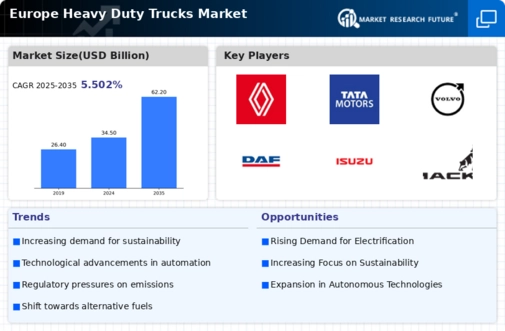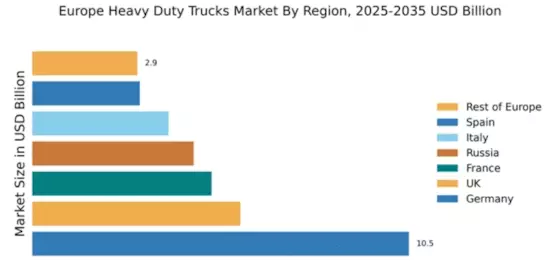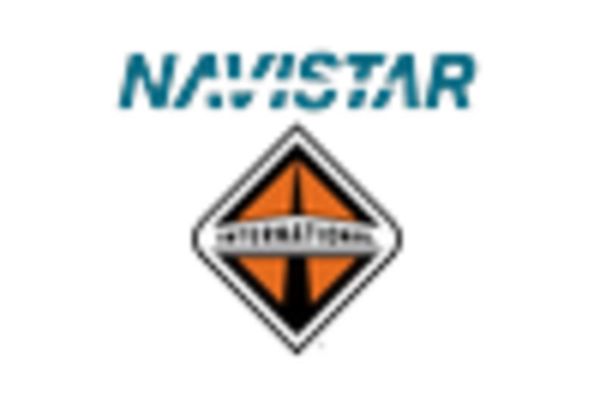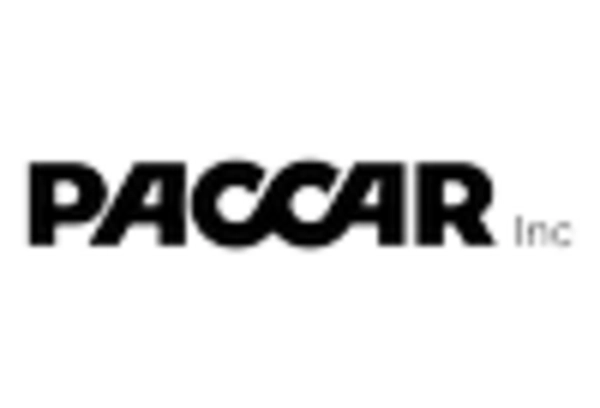Shift Towards Sustainable Practices
The heavy duty-trucks market in Europe is increasingly influenced by a shift towards sustainable practices. Companies are recognizing the importance of sustainability in their operations, leading to a growing demand for eco-friendly trucks. This trend is reflected in the rising interest in alternative fuels, such as biodiesel and hydrogen, which are seen as viable options for reducing carbon footprints. Furthermore, many logistics companies are setting ambitious sustainability targets, aiming for a 50% reduction in emissions by 2030. This commitment to sustainability is likely to drive innovation in the heavy duty-trucks market, as manufacturers develop vehicles that align with these environmental goals, potentially reshaping the competitive landscape.
Infrastructure Development and Investment
Infrastructure development is a critical driver for the heavy duty-trucks market in Europe. The European Commission has allocated substantial funds for improving transportation networks, including roads and highways, which directly impacts the efficiency of heavy duty truck operations. Investments in infrastructure not only enhance connectivity but also reduce transit times, making logistics operations more efficient. For instance, the EU's Connecting Europe Facility aims to invest €30 billion in transport infrastructure by 2027. This investment is expected to facilitate smoother operations for heavy duty trucks, thereby stimulating demand within the market. As infrastructure improves, the heavy duty-trucks market is poised for growth, benefiting manufacturers and logistics providers alike.
Rising Demand for E-commerce and Logistics
The surge in e-commerce has created a robust demand for efficient logistics solutions, thereby driving the heavy duty-trucks market in Europe. With online shopping becoming increasingly prevalent, businesses require reliable transportation to ensure timely deliveries. According to recent data, the logistics sector is projected to grow by approximately 4.5% annually, which directly correlates with the demand for heavy duty trucks. This growth is further fueled by the need for last-mile delivery solutions, prompting logistics companies to invest in expanding their fleets. Consequently, the heavy duty-trucks market is likely to experience increased sales and production as companies seek to meet the evolving demands of consumers and businesses alike.
Technological Advancements in Truck Design
Technological advancements play a pivotal role in shaping the heavy duty-trucks market in Europe. Innovations such as improved aerodynamics, lightweight materials, and advanced engine technologies contribute to enhanced fuel efficiency and performance. For example, the introduction of composite materials can reduce vehicle weight by up to 20%, leading to lower fuel consumption and operational costs. Additionally, the integration of advanced driver-assistance systems (ADAS) enhances safety and operational efficiency. As manufacturers continue to invest in research and development, the heavy duty-trucks market is likely to witness a transformation in vehicle capabilities, which may attract new customers and retain existing ones.
Regulatory Compliance and Emission Standards
The heavy duty-trucks market in Europe is significantly influenced by stringent regulatory compliance and emission standards. The European Union has implemented various regulations aimed at reducing greenhouse gas emissions, which has led to a shift in the design and manufacturing of heavy duty trucks. For instance, the Euro 6 standards, which came into effect in 2014, require manufacturers to limit nitrogen oxide emissions to 0.4 g/km. This regulatory environment compels manufacturers to innovate and invest in cleaner technologies, thereby impacting the overall market dynamics. As a result, companies that adapt to these regulations may gain a competitive edge, while those that fail to comply could face substantial penalties, affecting their market share in the heavy duty-trucks market.


















Leave a Comment